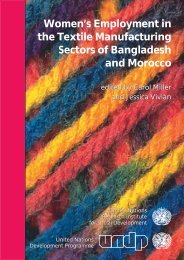communicating in the information society - United Nations Research ...
communicating in the information society - United Nations Research ...
communicating in the information society - United Nations Research ...
You also want an ePaper? Increase the reach of your titles
YUMPU automatically turns print PDFs into web optimized ePapers that Google loves.
What About Gender Issues <strong>in</strong> <strong>the</strong> Information Society?<br />
career options un<strong>in</strong>spir<strong>in</strong>g. Girls also show clear and strong ideas about<br />
<strong>the</strong> k<strong>in</strong>ds of games <strong>the</strong>y would design: games that feature simulation,<br />
strategy and <strong>in</strong>teraction. The girls’ critique po<strong>in</strong>ts to a more <strong>in</strong>clusive<br />
computer culture that embraces multiple <strong>in</strong>terests and backgrounds and<br />
that reflects <strong>the</strong> current ubiquity of technology <strong>in</strong> all aspects of life. In<br />
this framework, to be technologically literate requires a set of critical<br />
skills, concepts and problem-solv<strong>in</strong>g abilities. Based on its f<strong>in</strong>d<strong>in</strong>gs, <strong>the</strong><br />
commission is work<strong>in</strong>g on a new def<strong>in</strong>ition of computer literacy and<br />
equity. It acknowledges that obta<strong>in</strong><strong>in</strong>g gender equity <strong>in</strong> this field means<br />
us<strong>in</strong>g technology proactively, be<strong>in</strong>g able to <strong>in</strong>terpret <strong>the</strong> <strong>in</strong>formation that<br />
technology makes available, understand<strong>in</strong>g design concepts and be<strong>in</strong>g a<br />
lifelong learner of technology. In its recommendations, <strong>the</strong> commission<br />
states that girls should be educated to be ICT designers and not just<br />
users. Educators and parents should help girls imag<strong>in</strong>e <strong>the</strong>mselves early<br />
<strong>in</strong> life as designers and producers of technology, stimulat<strong>in</strong>g deeper<br />
<strong>in</strong>terest <strong>in</strong> ICTs and provid<strong>in</strong>g opportunities for girls to express <strong>the</strong>ir<br />
technological imag<strong>in</strong>ations (AAUW 2000).<br />
Many of <strong>the</strong> concepts underl<strong>in</strong>ed by <strong>the</strong> AAUW are evident <strong>in</strong><br />
fem<strong>in</strong>ist uses of ICT. In fem<strong>in</strong>ist use, women are not seen as consumers;<br />
ra<strong>the</strong>r, <strong>the</strong>y are encouraged to develop content where analytical skills,<br />
computer concepts and <strong>in</strong>novative uses of technology play an important<br />
role. Women’s electronic networks have created opportunities for women<br />
to learn about ICT tools <strong>in</strong> order to ma<strong>in</strong>ta<strong>in</strong> dynamic relationships,<br />
which empower and allow <strong>the</strong>m to build strategies and policies for <strong>the</strong><br />
advancement of <strong>the</strong>ir rights.<br />
“This issue of <strong>the</strong> role of women <strong>in</strong> creat<strong>in</strong>g <strong>the</strong> knowledge<br />
embodied <strong>in</strong> ICT networks is a key educational one” (Kirkup 2002:11, see<br />
paragraph 1.8.3). Women <strong>in</strong> <strong>the</strong>ir daily electronic network<strong>in</strong>g have been<br />
able to create multiple po<strong>in</strong>ts of access to ICT literacy. These practices<br />
have allowed <strong>the</strong>m to recognize <strong>the</strong>mselves <strong>in</strong> <strong>the</strong> culture of comput<strong>in</strong>g<br />
and have helped <strong>the</strong>m to overcome barriers created by gender bias.<br />
Women have found an <strong>in</strong>strument for <strong>the</strong>ir empowerment and emancipation<br />
<strong>in</strong> communication technologies. The Internet has allowed <strong>the</strong> voice<br />
of ord<strong>in</strong>ary citizens and organizations lack<strong>in</strong>g strong f<strong>in</strong>ancial resources<br />
to be heard. As <strong>the</strong> Internet provides a unique public sphere where<br />
decisions that shape people’s lives can be freely debated and considered,<br />
small groups and <strong>in</strong>dividuals, men and women—previously work<strong>in</strong>g <strong>in</strong><br />
isolation from one ano<strong>the</strong>r—have been able to communicate, network,<br />
share <strong>in</strong>formation and prepare actions <strong>in</strong> ways <strong>the</strong>y were never able to<br />
before (APC WNSP 2001). While more women are now tak<strong>in</strong>g part <strong>in</strong> this<br />
new technological practice, <strong>the</strong> dangers of deeper exclusion for those who<br />
do not have access to ICTs are, unfortunately, only too real for <strong>the</strong><br />
majority of women, especially <strong>in</strong> develop<strong>in</strong>g countries.<br />
21
















